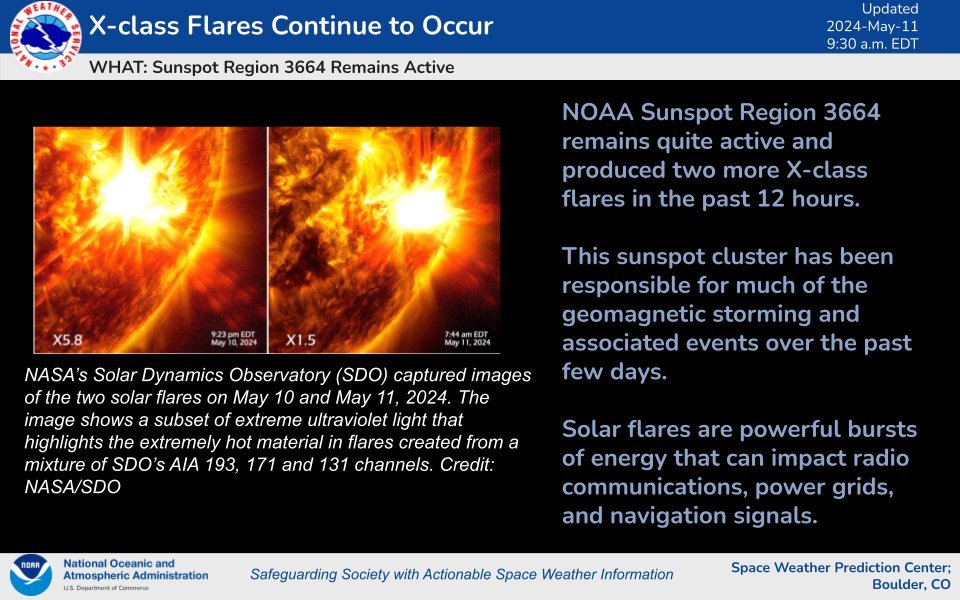Solar Storms and the Planetary Sunshade
Photo credit: Planetary Sunshade Foundation volunteer Brian Broom-Peltz, from Truckee, CA
The world is watching an intense aurora borealis show with fascination this weekend. Tonight could be even more intense.
We aren’t great at predicting these sorts of events, but NASA’s Solar Cruiser Mission would give us significantly more advance warning. (Congress should fund the Solar Cruiser mission and help us better prepare for events like this in the future - more on that below.)
What’s Happening
A massive solar storm resulting from a Coronal Mass Ejection (CME) is sending the largest wave of charged particles to Earth in 20 years.
Intense Magnetic Fields and Sunspots Dark regions, or sunspots, form on the sun's surface due to intense magnetic fields from its interior. These vast regions, cooler than the sun's usual surface, can trap solar plasma in magnetic flux ropes, which occasionally fling particles into the sun's atmosphere before collapsing back onto the surface.
Coronal Mass Ejections (CMEs)
Snapbacks of magnetic flux ropes can result in CMEs, where charged particles from the sun's corona are expelled into space. This weekend, Earth faces a series of CMEs heading its way causing geomagnetic storms upon impact.
Although NOAA experts rate this as a G5 event, they assure that the risk to Earth-based systems is likely minimal. This event marks the first severe storm since 2005, prompting a geomagnetic watch alert. Geomagnetic storms primarily affect sectors reliant on electromagnetic waves, such as high-frequency communication and GPS navigation. These storms can disrupt radio waves, affecting communication between ground and satellites, potentially leading to signal loss and decreased accuracy in determining locations.
Astronauts in the International Space Station are monitoring the event, and may need to take shelter deep inside the station. But for most people, the impact will be awe and wonder as they gaze up at the night sky.
Historical Context and Potential Severity
The most severe recorded geomagnetic storm, the 1859 Carrington event, caused widespread disruption, including auroras visible as far south as the Caribbean and telegraph communication failures. In 2012, a much more massive event narrowly missed earth, causing NASA to quote Daniel Baker of the University of Colorado: "If it had hit, we would still be picking up the pieces."
A modern Carrington-class storm could have catastrophic consequences, damaging satellites and the power grid, leading to prolonged societal and economic impacts.
Uncertainties and Preparedness
Forecasting the impact of CMEs remains challenging until they approach Earth. Despite advancements in monitoring and prediction, the potential for significant disruptions underscores the importance of preparedness and mitigation efforts across various sectors.
This storm could be nearly as powerful as the Carrington event, but we don’t know until very close to the impact. While the sun is 93 million miles away, it’s only when the CME gets to about a million miles away that we can measure it. That’s because of spacecraft at Earth-Sun Lagrange 1 which monitor space weather. These spacecraft are critical to managing our Earth systems.
Solar Cruiser Mission
NASA’s Solar Cruiser Mission is a very large solar sail design to study the sun. Because solar sails are designed to ‘catch’ solar radiation pressure, this spacecraft would orbit sunward of Earth-Sun Lagrange 1. The force of the solar radiation pressure and the force of gravity would be in balance, allowing the spacecraft to maintain this closer vantage point.
“When flown, Solar Cruiser will demonstrate the capability of a solar sail propelled spacecraft to provide up to 50% more warning time for solar storms, helping to prevent possible damage to spacecraft, the power grid, and other terrestrial infrastructure. It will also provide new vantage points for solar scientists to study the sun and improve their ability to predict when these storms will occur far in advance.”
Les Johnson, NASA Advanced In-Space Propulsion and Power, Science and Technology Office
The Solar Cruiser spacecraft is identical to a Planetary Sunshade. Like the early DARPA net to what eventually became the internet, Solar Cruiser would be a first step toward building a sunshade.
Read more about the importance of Solar Cruiser to the Planetary Sunshade effort.



